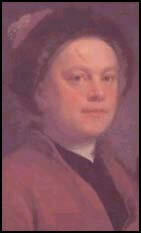Satirical artist and illustrator. Trained as an engraver, he depicted the unseemly behaviour of contemporaries in works like 'The Beggar's Opera' (1728) and 'A Rake's Progress' (1732). Much of his work was pirated and he was instrumental in the passing of the Copyright Act of 1735 which was known at the time as 'Hogarth's Act'. A governor of the Foundling Hospital. Born in Bartholomew Close, Smithfield, he lived in 'Leicester Fields' from 1726 until his death, and he died at home, the east side of Leicester Square. He was buried in Chiswick Parish at St. Nicholas, London, W4.
There are similarities between Hogarth and Dickens: the father being in a debtors' prison; the later successful representation of the individual lives of the poor.
A information board near the Chiswick statue gives:
In 1749 William Hogarth bought a small house at the edge of the riverside village of Chiswick. He could afford his “little country box” because of the success of his print sales. Over the next 15 years he added new rooms on the south side and a new second floor. Here he entertained family and friends as well as abandoned children from London’s Foundling Hospital, where he was a governor.
After his death William’s family continue to use the Chiswick house. Hogarth was buried at St Nicholas Church, along with his sister, his wife and her mother. His great friend, the actor David Garrick, wrote the epitaph carved on the magnificent tomb.
Since 1904 Hogarth’s House has been a small museum in his memory and the nearby roundabout is named after him.
London was Hogarth's home for his whole life and its streets and people appear in his pictures. His family was not rich, his father was even imprisoned for debt and William left his apprenticeship with a silver engraver before he finished his training. However, he became a very successful painter and print-maker.
Hogarth was a sharp businessman, selling his prints in the 1730s and '40s by subscription to middle class collectors who paid for them in advance. However, his series of prints telling moral stories were so popular that pirate versions were made by other print-sellers. His campaign for the first copyright law to protect artists' work succeeded in 1735.
After he became financially secure he worked from his town house in Leicester Fields (where the Leicester Square Odeon now stands). His widow, Jane, continued producing and selling his prints from there after his death in 1764.











Comments are provided by Facebook, please ensure you are signed in here to see them